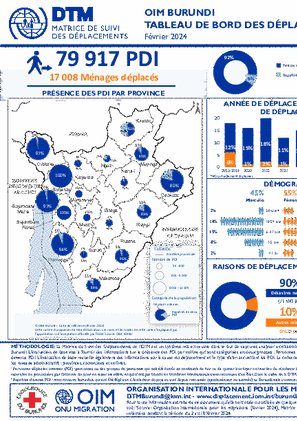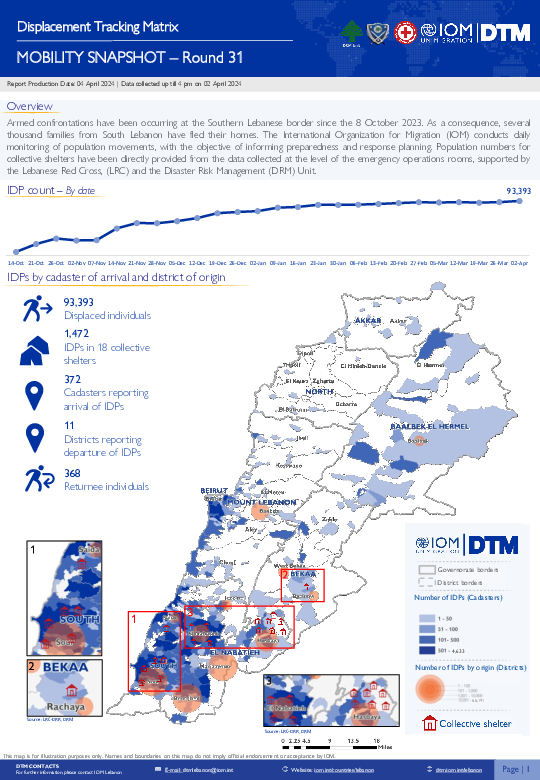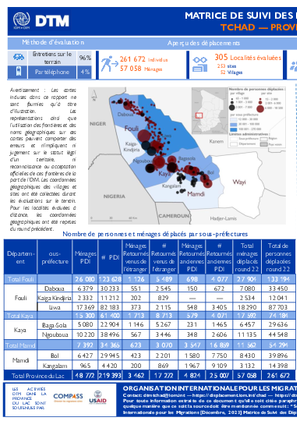-
Countries
-
Data and Analysis
-
Special Focus
-
Crisis Responses
Baseline Assessment

Contact
dtmlebanon@iom.int
Language
English
Location
Lebanon
Period Covered
Oct 10 2023
Apr 09 2024
Activity
- Mobility Tracking
- Baseline Assessment
Since October 8 there has been an increase in cross-border incidents between Israel and Lebanon, resulting in the displacement of people both within the South and elsewhere within the country. Since October 10, the Displacement Tracking Matrix (DTM) has been conducting the daily monitoring of population movements. The objective of the exercise is to inform preparedness and response planning.
Contact
DTM Sudan, DTMSudan@iom.int
Location
Sudan
Activity
- Mobility Tracking
- Baseline Assessment
Period Covered
Feb 22 2024 -Mar 21 2024
- DTM Sudan estimates that 6,552,118 individuals (1,308,617 households) have been recently internally displaced.
- IOM DTM also reports that an estimated 2,019,027 mixed cross-border movements have been made into neighbouring countries.
- Since 15 April 2023, 46 per cent of the IDP caseload sought refuge in the Darfur and Kordofan regions, whereas 53 per cent were observed across the Northern, Eastern, and Central states.
- The majority of the IDP caseload (66%) were seeking shelter with the host community.
- While food remains the highest priority need, health and non-food items are also growing concerns.
A more detailed version of this dataset is available, to get access kindly click on the 'Request Access' button
Population Groups
IDPs
Survey Methodology
Unit of Analysis Or Observation
Admin Area 3
Site or Location
Type of Survey or Assessment
Key Informant
Keywords
Geographical Scope Partial Coverage
Administrative boundaries with available data
The current dataset covers the following administrative boundaries
Contact
DTM Sudan, DTMSudan@iom.int
Location
Sudan
Activity
- Mobility Tracking
- Baseline Assessment
Period Covered
Mar 21 2024 -Mar 28 2024
- DTM Sudan estimates that 6,622,565 individuals (1,320,273 households) were recently internally displaced.
- The IDP caseload was observed in 7,076 locations across all of Sudan’s 18 states.
- The highest proportions of IDPs were observed across South Darfur (11%), River Nile (11%), and East Darfur (10%).
- Field teams reported that the IDPs observed were originally displaced from twelve states. The majority (3,570,032 IDPs, 54%) were reportedly displaced from Khartoum state; followed by South Darfur (15%), Aj Jazirah (9%), North Darfur (9%), Central Darfur (4%), West Darfur (4%), South Kordofan (2%), East Darfur (1%), West Kordofan (1%), North Kordofan (1%), Sennar (1%) and White Nile (<1%).
- IOM-DTM also reported that an estimated 2,031,858 mixed cross-border movements were made into neighbouring countries.
- This product provides brief insights into those displaced in Sudan post-15 April 2023. For more granular information on the IDP caseload and the displacement context, please see IOM-DTM's Monthly Displacement Overview 07.
A more detailed version of this dataset is available, to get access kindly click on the 'Request Access' button
Population Groups
IDPs
Survey Methodology
Unit of Analysis Or Observation
Site or Location
Type of Survey or Assessment
Key Informant
Keywords
Geographical Scope Partial Coverage
Administrative boundaries with available data
The current dataset covers the following administrative boundaries
Contact
dtmlebanon@iom.int
Location
Lebanon
Activity
- Mobility Tracking
- Baseline Assessment
Period Covered
Oct 10 2023 -Mar 26 2024
Since October 8 there has been an increase in cross-border incidents between Israel and Lebanon, resulting in the displacement of people both within the South and elsewhere within the country. Since October 10, the Displacement Tracking Matrix (DTM) has been conducting the daily monitoring of population movements. The objective of the exercise is to inform preparedness and response planning.
Aggregated data is available through the DTM API: https://dtm.iom.int/data-and-analysis/dtm-api
A more detailed version of this dataset is available, to get access kindly click on the 'Request Access' button
Population Groups
IDPs
Survey Methodology
Unit of Analysis Or Observation
Admin Area 2
Admin Area 3
Household
Individual
Type of Survey or Assessment
Key Informant
Keywords
Geographical Scope Full Coverage
Administrative boundaries with available data
The current dataset covers the following administrative boundaries
Contact
dtmlebanon@iom.int
Location
Lebanon
Activity
- Mobility Tracking
- Baseline Assessment
Period Covered
Oct 10 2023 -Mar 19 2024
Since October 8 there has been an increase in cross-border incidents between Israel and Lebanon, resulting in the displacement of people both within the South and elsewhere within the country. Since October 10, the Displacement Tracking Matrix (DTM) has been conducting the daily monitoring of population movements. The objective of the exercise is to inform preparedness and response planning.
Aggregated data is available through the DTM API: https://dtm.iom.int/data-and-analysis/dtm-api
A more detailed version of this dataset is available, to get access kindly click on the 'Request Access' button
Population Groups
IDPs
Survey Methodology
Unit of Analysis Or Observation
Admin Area 2
Admin Area 3
Household
Individual
Type of Survey or Assessment
Key Informant
Keywords
Geographical Scope Full Coverage
Administrative boundaries with available data
The current dataset covers the following administrative boundaries

Contact
DTM Burundi, DTMBurundi@iom.int
Language
English
Location
Burundi
Period Covered
Feb 01 2024
Feb 29 2024
Activity
- Mobility Tracking
- Baseline Assessment
La Matrice de Suivi des Déplacements de l’OIM est un système mis en œuvre dans le but de capturer, analyser et disséminer des informations pour mieux comprendre les mouvements et les besoins des personnes déplacées internes (PDI) au Burundi. L'évaluation de base vise à fournir des informations sur la présence des PDI par colline qui sont catégorisés en deux groupes: Personnes déplacées internes (PDI) incluant les PDI retournées dans leur colline d'origine mais pas dans leur maison et les rapatriés devenus PDI. L'évaluation de base recueille également des informations sur la cause du déplacement et le type d'abri accueillant les PDI. La collecte des données est effectuée quatre fois par an par des volontaires formés de la Croix-Rouge du Burundi et opérant à tous les niveaux administratifs: provinces, communes et collines.

Contact
dtmlebanon@iom.int
Language
English
Location
Lebanon
Period Covered
Oct 10 2023
Apr 02 2024
Activity
- Mobility Tracking
- Baseline Assessment
Since October 8 there has been an increase in cross-border incidents between Israel and Lebanon, resulting in the displacement of people both within the South and elsewhere within the country. Since October 10, the Displacement Tracking Matrix (DTM) has been conducting the daily monitoring of population movements. The objective of the exercise is to inform preparedness and response planning.

Contact
DTM Tchad, dtmtchad@iom.int
Language
French
Location
Chad
Period Covered
Dec 22 2023
Jan 24 2024
Activity
- Mobility Tracking
- Site Assessment
- Baseline Assessment
Depuis 2015, le Tchad fait l’objet d’attaques perpétrées par des groupes armés non-étatiques présents dans le bassin du Lac Tchad engendrant des déplacements massifs de populations, aussi bien internes que transfrontaliers. Au Tchad, l’OIM met en œuvre sa Matrice de suivi des déplacements (DTM, Displacement Tracking Matrix en anglais) dans la province du Lac depuis mai 2015 pour mesurer l’évolution du nombre, des profils et les besoins des populations déplacées à la suite de cette crise, afin de mieux orienter les programmes humanitaires et de développement. Les données sont collectées à travers des entretiens avec des informateurs clés (autorités locales, chefs traditionnels, représentants des personnes déplacées et gestionnaires de sites) dans les villages et sites d’accueil des personnes déplacées, ainsi que par des observations directes dans ces localités.
Ce tableau de bord présente les résultats des évaluations menées entre le 22 décembre 2023 et le 24 janvier 2024 dans 305 lieux de déplacement. Le Round 22 a enregistré une augmentation globale de 8 pour cent en termes de total de population déplacée par rapport au Round 21 dont 3 pour cent sur des sites existants, principalement dans les sous-préfectures de Liwa et Daboua, et 5 pour cent dus à des déplacements vers de nouveaux sites. Les principales raisons de l'augmentation de la population déplacée observée dans les lieux de déplacement évalués sont l'insécurité, qui se traduit principalement par des déplacements préventifs, les inondations de décembre 2023 et le retour de certaines personnes déplacées vers les zones d'agriculture et de pêche. La situation de déplacement dans la province du Lac reste volatile, avec la création de nouveaux sites de déplacement spontanés et l'abandon de certains sites existants. Cette collecte de données a été réalisée en partenariat avec la Commission Nationale d'Accueil et de Réinsertion des Réfugiés et Rapatriées (CNARR), le gouvernorat, l’Institut National de la Statistique, des Etudes Economiques et Démographiques (INSEED), le Ministère de l’Economie, du Plan et de la Coopération Internationale (MEPCI), le Comité Provincial d’Action (CPA) et l'Association pour l'Action Humanitaire et le Développement Durable (ACHDR). Les données ont été triangulées par la DTM et les acteurs humanitaires ont été impliqués dans l'analyse approfondie des données.

Contact
DTM Sudan; dtmsudan@iom.int
Language
English
Location
Sudan
Period Covered
Mar 21 2024
Mar 28 2024
Activity
- Mobility Tracking
- Baseline Assessment
Overview
On 15 April 2023, armed clashes erupted between the Sudanese Armed Forces (SAF) and the Rapid Support Forces (RSF) in multiple cities across Sudan. Clashes initially took place in cities across Northern and Khartoum states, later spreading across the Darfur and Kordofan regions.
Highlights
- DTM Sudan estimates that 6,622,565 individuals (1,320,273 households) were recently internally displaced.
- The IDP caseload was observed in 7,076 locations across all of Sudan’s 18 states.
- The highest proportions of IDPs were observed across South Darfur (11%), River Nile (11%), and East Darfur (10%).
- Field teams reported that the IDPs observed were originally displaced from twelve states. The majority (3,570,032 IDPs, 54%) were reportedly displaced from Khartoum state; followed by South Darfur (15%), Aj Jazirah (9%), North Darfur (9%), Central Darfur (4%), West Darfur (4%), South Kordofan (2%), East Darfur (1%), West Kordofan (1%), North Kordofan (1%), Sennar (1%) and White Nile (<1%).
- IOM-DTM also reported that an estimated 2,031,858 mixed cross-border movements were made into neighbouring countries.
- This product provides brief insights into those displaced in Sudan post-15 April 2023. For more granular information on the IDP caseload and the displacement context, please see IOM-DTM's Monthly Displacement Overview 07.

Contact
DTMUkraine@iom.int
Language
English
Location
Ukraine
Period Covered
Feb 01 2024
Feb 29 2024
Activity
- Baseline Assessment
Базова територіальна оцінка зареєстрованих ВПО надає деталізовані дані щодо чисельності та географічного розподілу офіційно зареєстрованих внутрішньо переміщених осіб (ВПО). У звіті оцінено присутність зареєстрованих ВПО на рівні громад із відображенням на мапі зафіксованих змін порівняно з попереднім раундом.
Дані, зібрані для раунду 33 Базової територіальної оцінки, відображають актуальну статистику з місцевого адміністративного реєстру ВПО станом на 29 лютого 2024 року, згідно з якою в Україні налічується 3 413 472 зареєстровані ВПО. Дані щодо кількості зареєстрованих ВПО було зібрано для 1 098 громад (83% усіх оцінених громад на підконтрольних українському уряду територіях) у 108 районах 23 областей. Дані з розподілом за віком, статтю та статусом інвалідності було надано для приблизно 83% оцінених адміністративно-територіальних одиниць.
Pagination
- Previous page
- Page 34
- Next page
